with作伴随状语
伴随状语的用法

伴随状语的用法With作为伴随状语,可以用来说明造成某一局面的原因或者伴随主句的动作发生。
使用现在分词或过去分词取决于与主句的关系是被动还是主动。
例如,with XXX表示随着时间的流逝,而He sat on the chair with his eyes closed表示他坐在椅子上闭着眼睛。
使用with的复合结构可以分为几种情况:一种是with+名词+形容词,表示处于一种状态,例如He often sleeps with windows open;另一种是with+名词+副词,例如There is a temple with no table in;还有一种是with+名词+介词短语,例如XXX into the classroom with a book under his arm;还有一种是with+名词+现在分词,表示动作的主动和进行态,例如The old woman left her house with water running all the time;还有一种是with+名词+过去分词,表示被动和完成,例如XXX his back;最后一种是with+名词+不定式,表示动作的将来式,例如The manager has been busy these days with a lot of work to do。
伴随状语指的是状语从句的动作伴随主句发生,其特点是所表达的动作或状态是伴随着句子谓语动词的动作而发生或存在的。
例如,He sat in the armchair。
reading a XXX表示他坐在扶手椅里读报,All night long he lay awake。
thinking of the problem表示他整夜躺在床上睡不着,思考着那个问题。
通常在分词短语(现在分词表主动,过去分词表被动)前有逗号的是伴随状语,例如The dog entered the room。
with的伴随状语用法
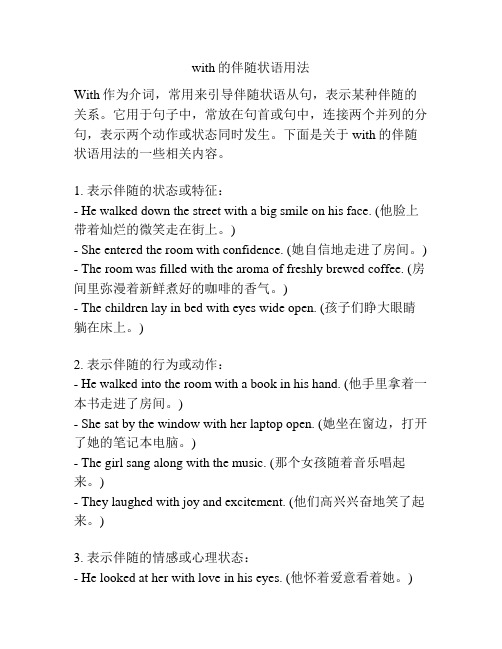
with的伴随状语用法With作为介词,常用来引导伴随状语从句,表示某种伴随的关系。
它用于句子中,常放在句首或句中,连接两个并列的分句,表示两个动作或状态同时发生。
下面是关于with的伴随状语用法的一些相关内容。
1. 表示伴随的状态或特征:- He walked down the street with a big smile on his face. (他脸上带着灿烂的微笑走在街上。
)- She entered the room with confidence. (她自信地走进了房间。
) - The room was filled with the aroma of freshly brewed coffee. (房间里弥漫着新鲜煮好的咖啡的香气。
)- The children lay in bed with eyes wide open. (孩子们睁大眼睛躺在床上。
)2. 表示伴随的行为或动作:- He walked into the room with a book in his hand. (他手里拿着一本书走进了房间。
)- She sat by the window with her laptop open. (她坐在窗边,打开了她的笔记本电脑。
)- The girl sang along with the music. (那个女孩随着音乐唱起来。
)- They laughed with joy and excitement. (他们高兴兴奋地笑了起来。
)3. 表示伴随的情感或心理状态:- He looked at her with love in his eyes. (他怀着爱意看着她。
)- She listened to the news with concern. (她关切地听着新闻。
)- They cheered with relief after the exam was over. (考试结束后,他们如释重负地欢呼起来。
with的伴随状语用法
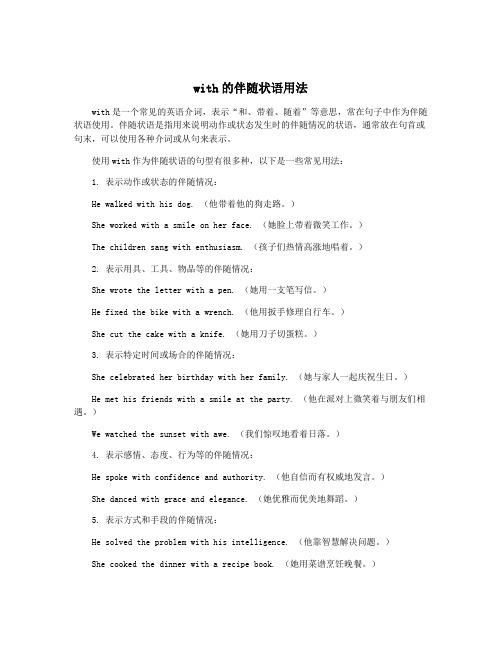
with的伴随状语用法with是一个常见的英语介词,表示“和、带着、随着”等意思,常在句子中作为伴随状语使用。
伴随状语是指用来说明动作或状态发生时的伴随情况的状语,通常放在句首或句末,可以使用各种介词或从句来表示。
使用with作为伴随状语的句型有很多种,以下是一些常见用法:1. 表示动作或状态的伴随情况:He walked with his dog. (他带着他的狗走路。
)She worked with a smile on her face. (她脸上带着微笑工作。
)The children sang with enthusiasm. (孩子们热情高涨地唱着。
)2. 表示用具、工具、物品等的伴随情况:She wrote the letter with a pen. (她用一支笔写信。
)He fixed the bike with a wrench. (他用扳手修理自行车。
)She cut the cake with a knife. (她用刀子切蛋糕。
)3. 表示特定时间或场合的伴随情况:She celebrated her birthday with her family. (她与家人一起庆祝生日。
)He met his friends with a smile at the party. (他在派对上微笑着与朋友们相遇。
)We watched the sunset with awe. (我们惊叹地看着日落。
)4. 表示感情、态度、行为等的伴随情况:He spoke with confidence and authority. (他自信而有权威地发言。
)She danced with grace and elegance. (她优雅而优美地舞蹈。
)5. 表示方式和手段的伴随情况:He solved the problem with his intelligence. (他靠智慧解决问题。
)She cooked the dinner with a recipe book. (她用菜谱烹饪晚餐。
with 伴随状语

with 伴随状语
with引导的伴随状语有以下几种:
1、“with+名词/代词+介词短语”
The master was walking up and down with the ruler under his arm.
大师腋下夹着尺子走来走去。
2、“with+名词/代词+形容词”
She came into the room, with her nose red because of cold.
她走进房间,因为感冒鼻子发红。
3、“with+名词/代词+副词”
With the meal over we all went home.
吃完饭,我们都回家了。
4、“with+名词/代词+名词”
She used to sit reading in the evening with her pet dog her only companion.
她从前总爱在晚上坐着看书她的宠物狗便是她唯一的伙伴。
5、“with+ 名词/代词+done”
With so much word done, he felt happy.
做完了这么多事情,他感到很高兴。
6、“with+ 名词/代词+ing分词”
With such work being done, he went home.
这些工作还在进行中,他就回家了。
7、“with+宾语+to do”
With so much work to do, he felt worried.
有这么多工作要做,他感到担心。
with表伴随放在句首6种用法
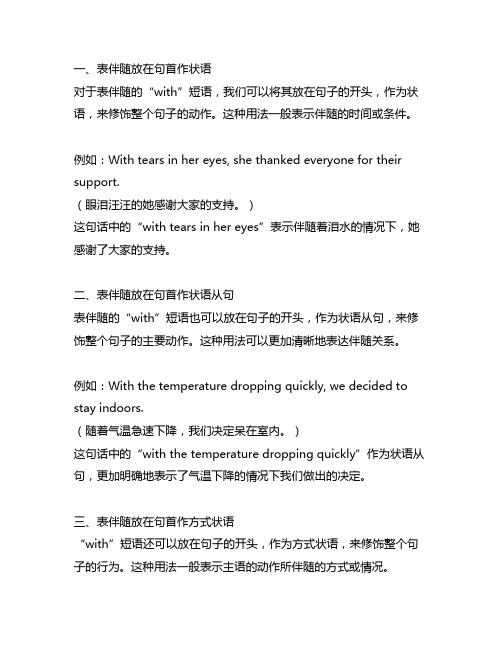
一、表伴随放在句首作状语对于表伴随的“with”短语,我们可以将其放在句子的开头,作为状语,来修饰整个句子的动作。
这种用法一般表示伴随的时间或条件。
例如:With tears in her eyes, she thanked everyone for their support.(眼泪汪汪的她感谢大家的支持。
)这句话中的“with tears in her eyes”表示伴随着泪水的情况下,她感谢了大家的支持。
二、表伴随放在句首作状语从句表伴随的“with”短语也可以放在句子的开头,作为状语从句,来修饰整个句子的主要动作。
这种用法可以更加清晰地表达伴随关系。
例如:With the temperature dropping quickly, we decided to stay indoors.(随着气温急速下降,我们决定呆在室内。
)这句话中的“with the temperature dropping quickly”作为状语从句,更加明确地表示了气温下降的情况下我们做出的决定。
三、表伴随放在句首作方式状语“with”短语还可以放在句子的开头,作为方式状语,来修饰整个句子的行为。
这种用法一般表示主语的动作所伴随的方式或情况。
例如:With great care, she arranged the flowers in the vase. (她小心翼翼地把花摆放在花瓶里。
)这句话中的“with great care”表示她摆放花的方式是小心翼翼的。
四、表伴随放在句首作条件状语“with”短语还可以放在句子的开头,作为条件状语,来修饰整个句子的情况。
这种用法一般表示伴随的条件或前提。
例如:With enough time, we could finish the project by tomorrow.(如果有足够的时间,我们明天就能完成这个项目。
)这句话中的“with enough time”表示有足够的时间作为条件,就能在明天完成这个项目。
with引导的伴随状语

with引导的伴随状语一、什么是伴随状语?伴随状语是指在句子中用来说明主语或谓语的动作所伴随的情况或状态的状语。
常见的引导词有with、along with、together with等。
二、with引导的伴随状语1. with + 名词(1)He walked to the park with his dog.他带着他的狗走到公园。
(2)She went to the party with her friends.她和她的朋友们一起去参加派对。
2. with + 动名词(1)She fell asleep with the TV on.她开着电视睡着了。
(2)He finished his homework with music playing in the background.他在背景音乐下完成了作业。
3. with + 形容词(1)She looked at him with a sad expression.她带着悲伤的表情看着他。
(2)He spoke to her in a calm voice, with a smile on his face.他以平静的声音和微笑面对她。
4. with + 副词(1)She ran down the street with great speed.她以极快的速度沿街跑去。
(2)He listened to her story attentively, with great interest.他专注地听她讲故事,非常感兴趣。
5. 与其他介词搭配使用(1)along withHe went to the beach along with his family.他和他的家人一起去海滩。
(2)together withShe wrote the report together with her colleagues.她和同事一起写报告。
三、注意事项1. 伴随状语通常位于句子中间或结尾,但在强调时可放在句首。
with 伴随状语用法

with 伴随状语用法with 伴随状语用法在英语中,我们经常使用”with”来表达伴随的关系,也就是两个事物或行为同时发生。
在这种情况下,我们可以使用”with”引导的伴随状语从句来描述这种关系。
下面将列举一些常见的用法,并进行详细解释。
1. 表示伴随的方式以下是几种常见的用法,它们都表示两个事物或行为之间的伴随关系:•with + 名词:表示两个事物或行为同时存在。
例子:–He walked down the street with his dog.–She writes her essays with a pen.•with + 代词/名词 + 动词:表示伴随的动作或状态。
例子:–She sat on the bench with her eyes closed.–He stood by the window with his arms crossed.•with + 名词短语:表示伴随的具体情境。
例子:–The children played in the park with their friends.–I had dinner with my family at a fancy restaurant.•with + 名词短语 + 形容词/副词:表示伴随的特定方式或特征。
例子:–He shouted with excitement.–They walked in silence with their heads down.2. 注意事项•当”with”引导的伴随状语从句作为句首时,需要使用逗号将其与句子主体分开。
当作为句子的一部分出现时,不需要使用逗号。
例子:–With a smile on her face, she greeted everyone at the party. (作为句首)–She greeted everyone at the party with a smile on her face. (作为句子一部分)•“with”引导的伴随状语从句可以放在句子的任意位置,但通常放在句首或句尾,以突出伴随关系。
with伴随状语用法

with伴随状语用法“with”作为一个小的介词在英语中经常被用作伴随状语,来表示两个动作的同时发生或者同时进行,而且其表达的意思也很丰富而多样。
首先,“with”可以表示某种行为正在同时进行,既有一种动作,也可以表示某种行为正在并行进行。
例如,She is walking with her brother(她正和她的弟弟一起散步);My mother is cooking dinner with my father(我的父母正一起做晚饭)。
其次,“with”也可以表示某种行为正在使用某种工具和器具而进行。
例如,He is playing the guitar with a pick(他正用一个拨片演奏吉他);She is writing a letter with a pen(她正用钢笔写信)。
此外,“with”也可以表示某种行为伴随着某种情绪而进行。
例如,She is singing with joy(她正伴随着欢乐地歌唱);He is swimming with fear(他正伴随着恐惧地游泳)。
此外,“with”还可以表示某种行为伴随着某种材料、某种物品而进行。
例如,He is walking with his umbrella(他正伴随着雨伞走路);She is painting with watercolor(她正用水彩画画)。
此外,“with”还可以表示某种行为伴随着某种动作而进行。
例如,He is dancing with the music(他正伴随着音乐跳舞);She is running with the wind(她正伴随着风奔跑)。
“with”作为一个小的介词在英语中经常被用作伴随状语,它可以表示某种行为在同时进行,同时使用某种工具或器具,伴随着某种情绪或者某种物品进行,也可以伴随着某种动作而进行。
它的应用功能很强,可以帮助我们更好的表达某种行为的伴随性,从而更好地描述某种情景或者描述某种行为。
with引导的状语

with引导的状语
with引导的状语可以用来修饰主句中的动词、形容词、副词等。
常用的with引导的状语包括:
1. with + 名词:表示伴随情况,如:
- She went to the park with her friends.
- He looked at me with a smile on his face.
2. with + 副词/形容词:表示方式或状态,如:
- He walked with confidence.
- She looked at him with disdain.
3. with + 动名词:表示动作同时进行的情况,如:
- He came into the room with a book in his hand.
- She drove the car with her eyes closed.
4. with + 过去分词:表示被动或完成的状态,如:
- The letter was sent with a stamp on it.
- The food was cooked with great care.
5. with + 等比较级:表示与某事物相比,如:
- He runs faster with each passing day.
- She is getting stronger with each workout.。
with作伴随状语
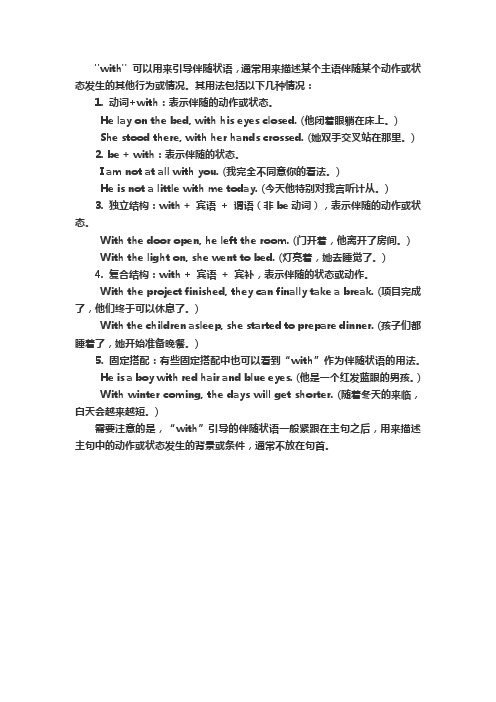
"with" 可以用来引导伴随状语,通常用来描述某个主语伴随某个动作或状态发生的其他行为或情况。
其用法包括以下几种情况:1. 动词+with:表示伴随的动作或状态。
He lay on the bed, with his eyes closed. (他闭着眼躺在床上。
)She stood there, with her hands crossed. (她双手交叉站在那里。
)2. be + with:表示伴随的状态。
I am not at all with you. (我完全不同意你的看法。
)He is not a little with me today. (今天他特别对我言听计从。
)3. 独立结构:with + 宾语+ 谓语(非be动词),表示伴随的动作或状态。
With the door open, he left the room. (门开着,他离开了房间。
)With the light on, she went to bed. (灯亮着,她去睡觉了。
)4. 复合结构:with + 宾语+ 宾补,表示伴随的状态或动作。
With the project finished, they can finally take a break. (项目完成了,他们终于可以休息了。
)With the children asleep, she started to prepare dinner. (孩子们都睡着了,她开始准备晚餐。
)5. 固定搭配:有些固定搭配中也可以看到“with”作为伴随状语的用法。
He is a boy with red hair and blue eyes. (他是一个红发蓝眼的男孩。
) With winter coming, the days will get shorter. (随着冬天的来临,白天会越来越短。
)需要注意的是,“with”引导的伴随状语一般紧跟在主句之后,用来描述主句中的动作或状态发生的背景或条件,通常不放在句首。
with的伴随状语

with的伴随状语With的伴随状语是指在句子中用来修饰with的状语,用来说明with 所表示的伴随关系的状语。
这些状语可以是介词短语、副词、形容词或名词等,它们的作用是进一步说明with所表示的伴随关系,使句子更加准确、生动、形象。
一、介词短语作伴随状语1. With the help of his friends, he finally finished the project.2. With the passage of time, people's attitudes towards life have changed.3. With the development of technology, our lives have become more convenient.二、副词作伴随状语1. With great enthusiasm, he participated in the sports meeting.2. With a smile on her face, she greeted us warmly.3. With care and patience, the doctor treated the patient.三、形容词作伴随状语1. With his eyes closed, he enjoyed the music.2. With his arms crossed, he looked angry.3. With her hair tied back, she looked neat and tidy.四、名词作伴随状语1. With the sun shining brightly, we went for a picnic.2. With the rain pouring down, we had to cancel the outdoor activity.3. With the wind blowing fiercely, the trees swayed back and forth.总之,with的伴随状语可以是介词短语、副词、形容词或名词等,它们的作用是进一步说明with所表示的伴随关系,使句子更加准确、生动、形象。
with伴随状语和后置定语

with伴随状语和后置定语一、with伴随状语1. 概念- with伴随状语是一种状语形式,用来表示伴随状况、原因、方式等。
它在句子中起到补充说明主句动作发生时的伴随情况的作用。
- 例如:The teacher came into the classroom with a book in his hand.(“with a book in his hand”就是伴随状语,表示老师走进教室时伴随的状况——手里拿着一本书)2. 结构与用法- with+名词/代词+介词短语- 如:She left the room with tears in her eyes.(“tears”是名词,“in her eyes”是介词短语,整体表示她离开房间时眼睛里含着泪这种伴随状况) - with+名词/代词+形容词- 例如:He often sleeps with the window open.(“window”是名词,“open”是形容词,说明他睡觉的时候窗户是开着的这种伴随状态) - with+名词/代词+副词- 像:The boy ran out with his shoes on.(“shoes”是名词,“on”是副词,表示男孩跑出去时鞋子穿着的伴随情况)- with+名词/代词+现在分词- 例如:With the boy leading the way, we had no trouble finding the old man's house.(“the boy”是名词,“leading the way”是现在分词短语,表示在男孩带路这个伴随动作下,我们找到老人房子没有困难)- with+名词/代词+过去分词- 如:With the work finished, they went home happily.(“work”是名词,“finished”是过去分词,表示工作完成这个伴随情况,然后他们高兴地回家了)3. 在句子中的位置- 一般位于句首或者句末。
伴随状语with

伴随状语with伴随状语with在英语中常用来表示伴随的事物或状态。
在不同的语境中,with可以表示伴随、附带、具备等意思。
本文将围绕这一标题展开,探讨with的不同用法和意义,以及在实际语言交流中的应用。
一、with的基本用法及意义1. 表示伴随:with常用来表示某个人或物与另一个人或物一起存在或行动。
比如:- He went to the party with his friends.(他和他的朋友们一起去了派对。
)- She always goes to work with her dog.(她总是带着她的狗去上班。
)2. 表示附带:with可以表示某事物伴随着另一事物一起出现或存在。
比如:- The package came with a free gift.(这个包裹附带了一个免费礼物。
)- The book comes with a CD-ROM.(这本书带有一张光盘。
)3. 表示具备:with可以表示某人或物具备某种特征或性质。
比如: - He is a man with great patience.(他是一个有很强耐心的人。
) - She is a woman with a good sense of humor.(她是一个有很好幽默感的女人。
)二、with的常见搭配及用法1. 伴随动词:with常与一些动词搭配使用,表示某人或物伴随着某种行为或状态。
比如:- He walked with a limp.(他一瘸一拐地走着。
)- She sang with a beautiful voice.(她用美妙的声音唱着。
)2. 伴随名词:with常与名词搭配使用,表示某人或物伴随着某种特征或状态。
比如:- The room was filled with laughter.(房间里充满了笑声。
)- The city is famous for its buildings with unique designs.(这个城市以其独特设计的建筑而闻名。
伴随状语的用法
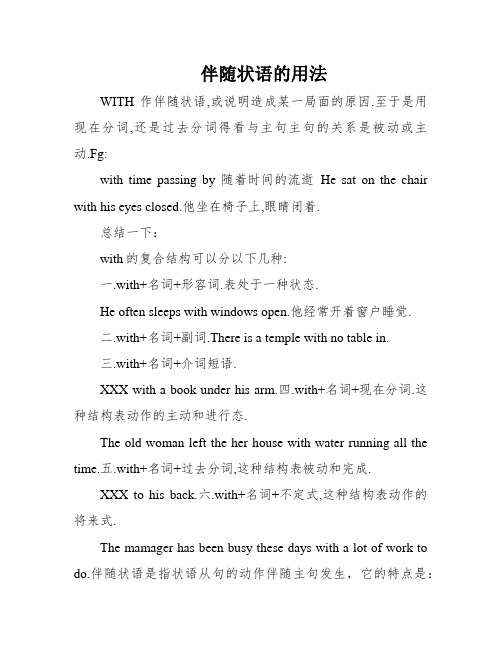
伴随状语的用法WITH作伴随状语,或说明造成某一局面的原因.至于是用现在分词,还是过去分词得看与主句主句的关系是被动或主动.Fg:with time passing by随着时间的流逝He sat on the chair with his eyes closed.他坐在椅子上,眼睛闭着.总结一下:with的复合结构可以分以下几种:一.with+名词+形容词.表处于一种状态.He often sleeps with windows open.他经常开着窗户睡觉.二.with+名词+副词.There is a temple with no table in.三.with+名词+介词短语.XXX with a book under his arm.四.with+名词+现在分词.这种结构表动作的主动和进行态.The old woman left the her house with water running all the time.五.with+名词+过去分词,这种结构表被动和完成.XXX to his back.六.with+名词+不定式,这种结构表动作的将来式.The mamager has been busy these days with a lot of work to do.伴随状语是指状语从句的动作伴随主句发生,它的特点是:它所表达的动作或状态是伴随着句子谓语动词的动作而发生或存在的。
比方:①He sat in the armchair,reading a XXX.他坐在扶手椅里读报。
②All night long he lay XXX,thinking of the problem.他整夜躺在床上睡不着,斟酌着那个题目。
伴随状语的判断The dog entered the room, following his master.普通在分词短语(目前分词表主动过去表被动)前有逗号的是相伴状语。
with结构的伴随状语

with结构的伴随状语with结构作为伴随状语时,主要用于表示伴随或附加的情景、条件、方式等。
其用法灵活多变,以下分述其不同类型与应用场景:伴随(动作同时发生)with结构最常见的用法是表示动作同时发生或伴随。
例如:He played the violin with great passion.She can work effectively with little supervision.The kittens cuddled up with their mother.在这些句子里,with表示动作同时进行或伴随着另一个动作。
条件(满足条件的动作)with结构也可以表示条件,即一个动作的发生以另一个动作或状态的满足为前提。
例如:With preparation, the exam will be easy.I can't go out without my keys.With the right tools, the job will be done quickly.这些句子中,with所引导的条件子句表示动作发生的条件或前提。
方式(动作发生的方式)with结构还能表示动作发生的方式或状态。
例如:He greeted me with a warm smile.The children ran around with joy.She was angry with him for breaking her trust.这些句子里,with所引导的介词短语描述了动作发生的方式或状态。
附加(额外的信息)with结构有时用于提供附加信息,例如动作的工具、地点或人物。
例如:He painted the house with a brush.We met with our friends at the park.The car was parked with its windows open.这些句子里,with所引导的介词短语提供了动作的附加信息。
with伴随状语

with伴随状语
with伴随状语是一种常用的语法结构,用来表示主句的动作或状态同时伴随着另一种动作或状态。
with伴随状语的形式有以下几种:
with+名词/代词+介词短语,例如:He walked away with a smile on his face.他带着微笑走开了。
with+名词/代词+形容词,例如:She looked at me with surprise.她惊讶地看着我。
with+名词/代词+副词,例如:The door opened with a loud noise.门发出巨大的响声打开了。
with+名词/代词+名词,例如:He came back with a bag of apples.他拎着一袋苹果回来了。
with+名词/代词+过去分词,例如:With the problem solved,we felt relieved.问题解决了,我们感到轻松了。
with+名词/代词+现在分词,例如:With the sun setting,the sky turned red.太阳落山了,天空变成了红色。
with+名词/代词+不定式,例如:With so much to do,he had no time to rest.有这么多事要做,他没有时间休息。
with表伴随状语的用法

with表伴随状语的用法一、什么是with表伴随状语?With表伴随状语是英语中常用的一种状语,用来表示某个动作或状态与另一个动作或状态同时发生或存在。
它通常由介词with和名词、代词、动名词、不定式等构成。
例如:1. She walked to the park with her dog.2. He is studying for the exam with his classmates.3. We enjoyed the concert with our friends.二、with表伴随状语的位置With表伴随状语可以放在主句中任何位置,但通常放在谓语动词之后,它与主语之间要加上逗号。
例如:1. I went to the cinema, with my friends.2. She is playing tennis, with her brother.3. They are having a picnic, with their neighbors.三、with表伴随状语的用法1. 表示陪同With表伴随状语可以表示某人陪同另一个人一起做某事。
例如:1. She went to the shopping mall with her mother.2. He traveled to Europe with his girlfriend.2. 表示工具或手段With表伴随状语还可以表示使用某种工具或手段来完成某个动作。
例如:1. I wrote this letter with a pen.2. They cut the cake with a knife.3. 表示条件With表伴随状语还可以表示某个动作或状态的发生需要满足一定的条件。
例如:1. With enough money, we can buy a new car.2. With hard work, you can achieve your goals.4. 表示感受With表伴随状语还可以表示某个动作或状态给人带来的感受。
伴随状语的用法

伴随状语的用法WITH作伴随状语,或说明造成某一局面的原因.至于是用现在分词,还是过去分词得看与主句主句的关系是被动或主动. Fg:with time passin g by随着时间的流逝He sat on the chairwith his eyes closed.他坐在椅子上,眼睛闭着.总结一下:with的复合结构可以分以下几种:一. w ith + 名词 + 形容词.表处于一种状态.He oftensleeps with window s open.他经常开着窗户睡觉.二.with +名词 + 副词. Thereis a temple with no tablein.三.with +名词 + 介词短语.The teache r came into the classr oom with a book underhis arm.四.with + 名词 + 现在分词.这种结构表动作的主动和进行态.The old womanleft the her housewith waterrunnin g all the time.五.with + 名词 + 过去分词,这种结构表被动和完成.The thiefwas takento the police statio n with his handstied to his back. 六.with + 名词 + 不定式,这种结构表动作的将来式.The mamage r has been busy thesedays with a lot of work to do .伴随状语是指状语从句的动作伴随主句发生,它的特点是:它所表达的动作或状态是伴随着句子谓语动词的动作而发生或存在的。
例如:①He sat in the armcha ir,readin g a newspa per. 他坐在扶手椅里读报。
with的用法

with的用法with是英语中最常见的介词,它的含义很广泛,在英语的句法结构中有着至关重要的作用。
本文将讨论with的用法,包括它用于不同句法结构中的意义以及用法上的一些高级特征。
一、与不同句法结构的关系1. 作伴随状语with是一个多功能的介词,可以用作伴随状语。
它可以表明动作的对象、对象的状态或处境等。
例如:He ran with his dog. 他和他的狗一起跑。
She walked with her head down.低着头走路。
2. 作表语with也可以作表语,表达和别人的关系或内心状态等。
例如: He is angry with me. 他对我很生气。
She was happy with the result.对结果很满意。
3. 作定语with还可以作定语,表达对象的特征、特性、状况等。
例如: The girl with brown hair.个深褐色头发的女孩。
The boy with autism.个患有自闭症的男孩。
4. 作状语with可以作状语,用来表示动作的方式、手段等。
例如:He looked at me with anger. 他怒目而视我。
She spoke with a soft voice.轻声说话。
二、with示相关性1.示搭配with以用来表示字符、物品、事件等之间的搭配关系。
例如: He ate the apple with a knife. 他用刀切苹果吃。
She drank the tea with honey.加蜂蜜喝茶。
2.示联合with可以表示不同实体之间的联合关系。
例如:We are working with the government.们正和政府合作。
She is travelling with her friends.正和朋友一起旅行。
3.示共同拥有with以用来表达实体之间共同拥有某样东西的关系。
例如:They worked on the project with enthusiasm. 他们充满热情地参与这个项目。
- 1、下载文档前请自行甄别文档内容的完整性,平台不提供额外的编辑、内容补充、找答案等附加服务。
- 2、"仅部分预览"的文档,不可在线预览部分如存在完整性等问题,可反馈申请退款(可完整预览的文档不适用该条件!)。
- 3、如文档侵犯您的权益,请联系客服反馈,我们会尽快为您处理(人工客服工作时间:9:00-18:30)。
As 与with 引导伴随
状语
as 与with 都可以构成结构来表示伴随状语,as 在此结构中是一个连词,而w ith 是一个介词,因此构成不同的结构来表示伴随状语:
区别:结构不同!with 引导的不是句子而是短语
As+主语+谓语动词,主句
With +名词、代词+介词、形容词,副词,分词,不定式
随着产量增长2 0%,.......
As the production incre ased by 20 percent, we
have had another good h arvest year.
With the production up by 20 percent, we have had another good harves t year.
He enjoys listening to music with his eyes clo sed.
他喜欢闭着眼睛听音乐。
He came out of the room with his eyes shining.
他走出房间,眼里闪着亮
光。
Don't speak with your m outh full.
嘴里吃东西时不要讲话。
Mother looked at me wit h tears in her eyes. 母亲含泪看着我。
with独立结构的位置可前可后,如:
With a lot of work to d o,he felt even busier. 有大量工作要做,他感到更忙了。
With a lot of work done, he felt he would have a good rest.
做完了工作,他感到他要好好休息一下。
练习:
1.with +名词(代词)+介词短语
他手托下巴chin,坐在那儿沉思。
He sat there thinking, with
那位老人背倚着墙站在那里。
2.with +名词(代词)+形容词
He stared at his f
riend
他张大嘴巴凝视着他
的朋友。
The man raised his
head
这人抬起头来,眼里
充满了好奇
3.with +名词(代词)+现在分词
She stood there chatti ng with her friend, wi th她站在那儿跟朋友闲聊,孩子在旁边玩。
With , I feel
very obliged to you.无论我什么时候遇到困难
你总是帮助我,真是太感激你了。
4.with +名词(代词)+过去分词
The goalkeeper left Ja pan with….这位守门员
离开了日本,而他的缺点却暴露无遗。
5. with +名词(代词)+不定式
With……, you’d be
tter hurry.
还有十分钟,你最好
快一点。
With….., our grou
p is sure to succe
ed.
有你领导我们,我们
组肯定能成功。
6.随着社会的发展
随着经济技术的发展progress
随着时间的流逝 pass by /go by/elapse/pass
随着时间的推移 go on
答案:
with his back against the
with his chin on his hand.
with his mouth wide open
with eyes full of wonder and
mystery.
With production up by 60%
With her child playing beside her.
With you helpin g me whenever I’m in trouble,
With his flaws laid bare.
With 10 minutes to go
With you to lead us。
